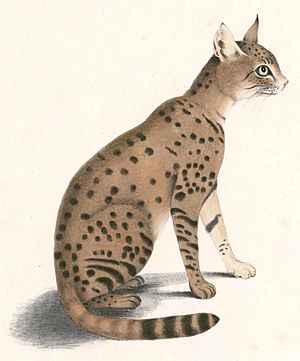Thomas Hardwicke facts for kids
Quick facts for kids
Thomas Hardwicke
FRS
|
|
|---|---|
 |
|
| Born | 1756 |
| Died | 3 March 1835 (aged about 78) Lambeth, London
|
| Known for | Collection of drawings of Indian animals |
| Awards | Fellow of the Linnean Society |
| Scientific career | |
| Fields | Soldier, zoologist |
| Institutions | British East India Company army |
| Author abbrev. (botany) | Hardw. |
| Author abbrev. (zoology) | Hardwicke |
Major-General Thomas Hardwicke (born 1756 – died 3 March 1835) was an English soldier and a naturalist. He spent many years in India, from 1777 to 1823. During his time there, he collected many animal specimens and had them painted by talented Indian artists. These amazing paintings helped scientists describe and name many new species of animals. Some of these species are even named after him! After returning to England, he worked with another zoologist, John Edward Gray, to create a special book called Illustrations of Indian Zoology.
Contents
Thomas Hardwicke's Life and Adventures
Thomas Hardwicke joined the British East India Company army on November 3, 1778. He started as a Lieutenant Fireworker in the Bengal Artillery. The British East India Company was a powerful trading company that also had its own army in India.
Military Career in India
Hardwicke was stationed in southern India from 1781 to 1785. He fought in several important battles. These included the Relief of Vellore in 1782 and the Siege of Cuddalore in 1783. He also took part in the campaign against Tipu Sultan from 1790 to 1792. During this time, he was wounded at Satyamangalam in 1790.
After his injury, he moved to Bengal in 1793. He became an Adjutant and Quartermaster of Artillery. He continued to rise through the ranks, becoming a Major-General in 1819. In 1823, he left the army and returned to England. He passed away in Lambeth, London, on March 3, 1835.
His Passion for Nature
While serving in the army, Hardwicke traveled all over India. He used these travels to collect many zoological specimens. He also gathered a huge collection of paintings of animals. He hired local Indian artists to create these detailed drawings. Most of the paintings were made from animals that had died. However, many were also drawn from live animals.
When he left India, Thomas Hardwicke had the largest collection of drawings of Indian animals ever made by one person! Some of these drawings were also made by his daughter, Elizabeth. She drew them between 1811 and 1815. Her poor health was one reason Hardwicke decided to leave India.

The Indian artists who worked for Hardwicke are mostly unknown. However, one artist named Goordial is mentioned. These artists were well-trained. They adapted their style to create technical illustrations using watercolors.
His Collection and Legacy
In 1835, Hardwicke left his amazing collection of drawings to the British Museum. Later, some of these drawings were moved to the Natural History Museum. The collection includes about 4,500 illustrations!
Hardwicke was very enthusiastic about India's natural history. He communicated with famous naturalists in England. He was in touch with Sir Joseph Banks, who was the President of the Royal Society. Hardwicke himself became a Fellow of the Royal Society in 1813.
His collection of illustrations was very useful for zoologists like J. E. Gray. Hardwicke paid for the publication of a two-volume book called Illustrations of Indian Zoology. This book had 202 large, hand-colored plates. Sadly, he died before the text part of the book was finished. Gray described and named many of the species in the book.

Hardwicke also collected drawings of plants. He had 16 volumes of illustrations of Plants of India. He also had about 136 drawings of fungi. These are now kept in the British Library in London.
Awards and Recognition
Thomas Hardwicke was elected a Fellow of the Royal Society on April 8, 1813. He also became a Fellow of the Linnean Society on March 20, 1804. He held important positions, such as vice-president of the Asiatic Society of Bengal. He was also an honorary member of the Royal Dublin Society.
Animals Named After Thomas Hardwicke
Many species have been named to honor Thomas Hardwicke's work as a naturalist and zoologist. Here are some examples:
- Parnassius hardwickii – a type of butterfly called the common blue Apollo
- Temera hardwickii – a type of ray called the finless sleeper ray
- Solegnathus hardwickii – a fish known as Hardwicke's pipefish or pallid seahorse
- Thalassoma hardwicke – a colorful fish called the sixbar wrasse
- Eublepharis hardwickii – a lizard known as the East Indian leopard gecko
- Saara hardwickii – a lizard called Hardwicke's spiny-tailed lizard
- Hydrophis hardwickii – a snake known as the spine-bellied sea snake
- Chloropsis hardwickii – a bird called the orange-bellied leafbird
- Gallinago hardwickii – a bird known as Latham's snipe
- Kerivoula hardwickii – a bat called Hardwicke's woolly bat
- Rhinopoma hardwickii – a bat known as the lesser mouse-tailed bat
The genus of a tree, Hardwickia binata, was also named after him by William Roxburgh. This tree is known for its very hard wood.

